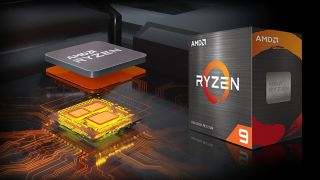AMD's 3D V-cache could be coming not only to CPUs, but GPUs too
A lot more Infinity Cache could be coming to Radeon GPUs.

AMD has already announced that it plans to release a Zen 3 refresh in early 2022 with 3D V-Cache. It’s a process aimed at vertically stacking cache in order to drastically boost the available L3 cache which can deliver a considerable performance increase. Word comes via Tom’s Hardware that AMD is in the process of trademarking the technology with the U.S. Patents and Trademarks Office. That alone wouldn’t be particularly newsworthy, but buried in the application are mentions of potential use cases that extend to other products beyond CPUs. Notably, GPUs.
AMD pulled out a surprise when its RX 6800 series proved to be very competitive against Nvidia's high end offerings. It managed to do so with what many considered to be an underwhelming 256-bit bus that delivered relatively limited memory bandwidth. AMDs reasoning for including a 256-bit bus was the inclusion of what it calls Infinity Cache. The 128MB of cache of the Navi 21 GPU is a big reason why AMD’s performance was so competitive despite its bandwidth disadvantage. The cache acts as an on-die store that lessens the need to access the VRAM. If 128MB is beneficial, then assuming AMD can scale its V-Cache technology onto its GPU products, then 256MB or 512MB or more of Infinity Cache could produce some rather dramatic performance gains.

Black Friday 2021 deals: the place to go for the all the best early Black Friday bargains.
Of course, this is just a trademark application, which means it's vague and broad. Many such applications end up going nowhere. But, given the importance and attention that AMD devoted to Infinity Cache at the time of the launch, we’re pretty sure that V-Cache is not going to be limited to CPUs. It might take a generation or two but its seems like AMD is committed to vertical stacking.
AMD claims that its CPUs with 3D V-Cache can deliver performance improvements of up to 15%, so if this tech makes it to GPUs, a 15% gain on top of the other improvements, and maybe even a multi-chip module design could potentially deliver a major performance leap. Not to be outdone, Nvidia’s Ada Lovelace GPUs are also rumoured to deliver major performance gains. 2022 is shaping up to be a great year for gamers.
The biggest gaming news, reviews and hardware deals
Keep up to date with the most important stories and the best deals, as picked by the PC Gamer team.

Chris' gaming experiences go back to the mid-nineties when he conned his parents into buying an 'educational PC' that was conveniently overpowered to play Doom and Tie Fighter. He developed a love of extreme overclocking that destroyed his savings despite the cheaper hardware on offer via his job at a PC store. To afford more LN2 he began moonlighting as a reviewer for VR-Zone before jumping the fence to work for MSI Australia. Since then, he's gone back to journalism, enthusiastically reviewing the latest and greatest components for PC & Tech Authority, PC Powerplay and currently Australian Personal Computer magazine and PC Gamer. Chris still puts far too many hours into Borderlands 3, always striving to become a more efficient killer.
Most Popular





